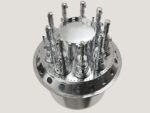In a milestone for Lithuania’s defense industrial base and military modernization efforts, the Lithuanian Armed Forces have officially received their first domestically produced Taurus 4×4 armored vehicle. Developed in cooperation with Israel’s Plasan and Lithuanian manufacturer MARS LT, the Taurus marks a significant leap in local production capability and NATO-standard force mobility.
Strategic Context: Lithuania’s Push for Defense Autonomy
As one of NATO’s easternmost members bordering Belarus and close to Russia’s Kaliningrad exclave, Lithuania has prioritized rapid modernization of its land forces. Since Russia’s full-scale invasion of Ukraine in 2022, Vilnius has accelerated procurement of armored vehicles and artillery systems to enhance maneuverability and survivability in high-threat environments.
The induction of the Taurus armored vehicle aligns with Lithuania’s broader strategic goals under its National Defense Development Program (NDDP) 2021–2030. This program emphasizes domestic industrial participation, NATO interoperability, and resilience against hybrid threats.
Taurus 4×4: Design Origins and Industrial Collaboration
The Taurus is based on the Israeli SandCat platform developed by Plasan—a global leader in survivability solutions. The Lithuanian iteration was customized through a joint venture between Plasan and MARS LT (Military Automotive Research Society), established specifically to adapt the SandCat architecture to Lithuanian operational needs.
- Chassis: Ford F550 Super Duty commercial chassis base
- Protection: STANAG 4569 Level II/III ballistic protection; mine protection up to Level IIa/b
- Crew capacity: Up to 10 personnel including driver
- Weight: Approx. 9–10 tonnes GVW depending on configuration
- Engine: Ford V8 turbo diesel (approx. 330 hp)
- Mobility: Independent suspension; run-flat tires; central tire inflation system optional
The modular design allows for multiple mission configurations including troop transport (APC), command post variant (CPV), reconnaissance roles, or light utility/logistics support. The first inducted unit is reportedly an APC configuration intended for infantry mobility under armor.
MARS LT Production Facility and Local Content Goals
MARS LT operates out of Radviliškis in northern Lithuania. The company was established in early 2023 as part of a strategic public-private initiative supported by the Ministry of National Defence (KAM). While initial production involves semi-knockdown kits from Israel with final assembly in Lithuania, future batches aim to increase local content—particularly welding, integration of communications gear, and maintenance training.
This local production model mirrors similar efforts across Eastern Europe where NATO members seek to reduce reliance on foreign suppliers while building sovereign capabilities. According to MARS LT executives speaking at the unveiling ceremony on September 15th, up to 60% local content may be achievable within two years depending on supply chain maturity.
NATO Interoperability and Deployment Role
The Taurus is designed from inception for compatibility with NATO C3I systems (Command, Control, Communications & Intelligence). It supports integration with standard VHF/UHF radios (e.g., Harris Falcon III), BMS platforms like Thales SOTAS or Elbit TORCH-X C2 suites depending on end-user requirements.
Lithuanian officials have stated that initial deployments will equip light infantry battalions within the Iron Wolf Mechanized Infantry Brigade—one of Lithuania’s key rapid response formations under NATO’s Enhanced Forward Presence (eFP) framework. The vehicle is expected to improve protected mobility during both national defense operations and multinational exercises such as Saber Strike or Iron Wolf drills held annually with allied forces.
Future Procurement Plans and Export Potential
The current order includes an undisclosed number of vehicles—estimated between 50–100 units over five years—with options for expansion based on operational feedback. The Lithuanian Ministry of Defence has not ruled out additional variants such as ambulance or mortar carrier configurations once field trials are complete.
MARS LT also sees export potential across Central Europe where countries like Latvia or Slovakia are seeking affordable but modern MRAP-class vehicles compatible with EU/NATO standards. Given its modularity and relatively low cost compared to heavier platforms like Patria AMV or Oshkosh JLTVs (~€300K–€500K per unit estimated), the Taurus could fill capability gaps for border patrols or internal security missions.
Conclusion: A Tactical Milestone with Strategic Implications
The induction of the Taurus armored vehicle represents more than just a new asset—it signals Lithuania’s intent to become an active contributor within NATO’s defense industrial ecosystem while enhancing national readiness against regional threats.
If follow-on production meets quality benchmarks and integration timelines remain on track, the program could serve as a template for other small nations seeking cost-effective force multipliers without full dependency on foreign OEMs. For now, it places Lithuania among a growing cohort of European states investing seriously in indigenous MilTech capabilities post-Ukraine war wake-up call.









